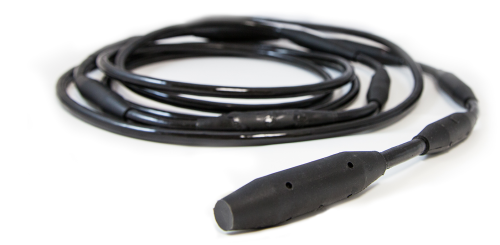






Überblick
Der CS225 ist eine Kette von Temperatursensoren eingebaut in einem verstärkten Stahlkabel. Er gibt die Daten im SDI-12 Format aus und kann überall da eingesetzt werden, wo ein Temperaturprofil aufgenommen werden soll. Da der Sensor sehr robust ist, kann er eingegraben, unter Wasser verwendet oder in direkt in Bauwerke eingebracht werden.
Anewndungsgebiete sind zum Beispiel
- Temperaturprofile in Bohrlöchern und Messungen am Grund von Bohrlöchern
- Erfassung von geothermalen Wärmegradienten
- Temperaturschichten in Seen
- Bodentemperaturprofile
- Wassertemperaturprofile
- Überwachung von Frosthebungen
- Schichtdickenmessung an Permafrost und Tiefenmessung
- Wärmeflussmessungen
Jeder CS225 wird individuell nach Kundenvorgeben gefertigt.
Lesen Sie mehrFunktionen und Vorteile
- One SDI-12 channel is used to connect all temperature sensors
- Low power—suitable for remote applications
- No calibration required
- Comprehensive measurement range
- Makes use of the included SGB3 to protect against electrical surges
- Extremely rugged and thoroughly tested
Bilder




Zugehörige Produkte
Technische Beschreibung
Rigorous Quality Testing of the CS225 Temperature String
We know clients need a really tough temperature string. These strings will be pulled through conduit, buried under concrete, frozen underground, and submersed in water, so quality is of the utmost importance. We put the CS225 through various tests to ensure it can withstand bending, pulling, pressure, freeze/thaw cycles, and temperature cycles. This series of tests confirmed the physical and electrical integrity of the CS225.
When power is supplied to the CS225 probe, the internal electronics will continuously measure the temperature at an approximate rate of 1 measurement per second. Every output measurement obtained from the sensor is a running average of 10 consecutive 1-second readings. The accuracy specification is based on an average of 10 consecutive readings. For this purpose, after initial power-up, it is recommended to delay 10 seconds to obtain the best accuracy.
Because the sensor is obtaining a measurement every 1 second, it is recommended to use the Continuous measurement command to obtain the temperature readings. Using the “R” commands will reduce the time taken to obtain a reading with the SDI-12 protocol.
Kompatibel mit
Please note: The following shows notable compatibility information. It is not a comprehensive list of all compatible products.
Datenlogger
| Product | Compatible | Note |
|---|---|---|
| CR1000 (retired) | ||
| CR300 (retired) | ||
| CR3000 | ||
| CR350 | ||
| CR6 | ||
| CR800 (retired) | ||
| CR850 (retired) |
Additional Compatibility Information
Configuration
Our handy CS225 Configuration Tool can help you configure your string, and it assists our staff with customizing your string to your specifications. It includes parameters for lead length, first sensor from ground, and distance between sensors.
Spezifikationen
| Operating Temperature Range | -55° to +85°C |
| Typical Accuracy | ±0.2°C (-40° to +85°C) includes lifetime drift |
| Worst Case Accuracy |
|
| Resolution | 0.0078°C |
| Maximum Pressure | 150 psi |
| Communications | SDI-12 |
| Maximum Sensors per Probe | 36 |
| Minimum Spacing | 15 cm (5.91 in.) |
| Supply Voltage | 9 to 28 Vdc |
| Current Consumption |
|
| Warm-up Time on Power up | 10 s |
| Temperature Point Diameter | 2.22 cm (0.875 in.) |
| Maximum Cable Length | 152 m (500 ft) |
| User-resettable min/max temperature recording | Yes |
| Min/max temperature recording duration | Lifetime |
| Automatic temperature update interval | 1 s |
Dokumente
Broschüren Produkte
Handbücher
Übereinstimmung mit Richtlinien u. Vorschriften
Downloads
CS255 Program Examples (4 KB) 26-08-2021
Three example programs that measure the temperature sensors on the CS225 probe. The number of temperature sensors and the SDI-12 control terminal are entered as constants at the beginning of the programs to allow users to easily change them to match their application. The example programs support the CR6 and CR1000X data loggers. Programming for other dataloggers will be similar.
The cs225.CRB program measures 20 sensors with SDI-12 addresses 1 through 9 and A through F. Every 60 s, the aR0! command polls each temperature sensor, then the data is stored in a table. Other common station data is measured every 60 seconds and stored to a daily data table.
The cs225-slow.CRB program measures 20 temperature sensors with SDI-12 addresses 1 through 9 and A through F. The program uses the SlowSequence instruction and the aR0! command to poll each temperature sensor every 60 seconds. The temperature sensor data is stored to a data table on the same interval. Other common station data is measured every 5 seconds and stored to daily and hourly data tables.
The cs225-metdata.CRB program measures 15 sensors with SDI-12 addresses 1 through 9 and A through F. Each temperature sensor is polled on power up and daily with the aR1! command to determine metadata, which is stored in a daily data table. Other common station data is measured every 60 seconds and stored to a separate daily data table.



